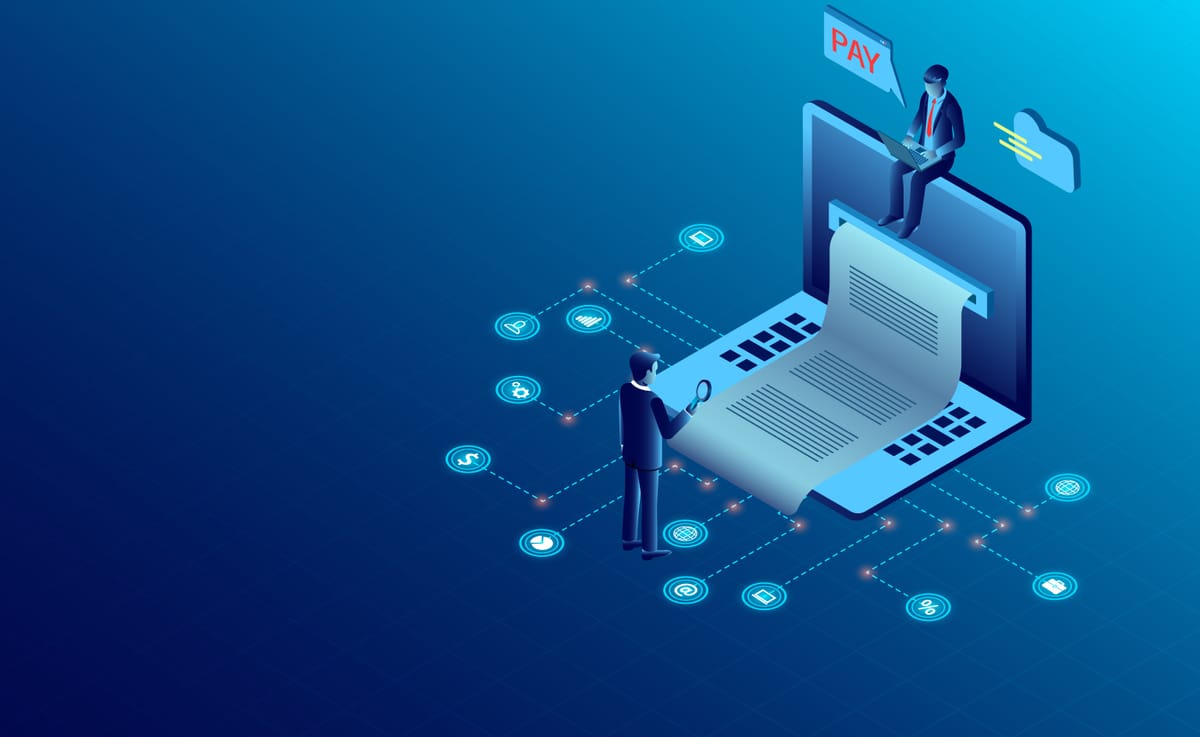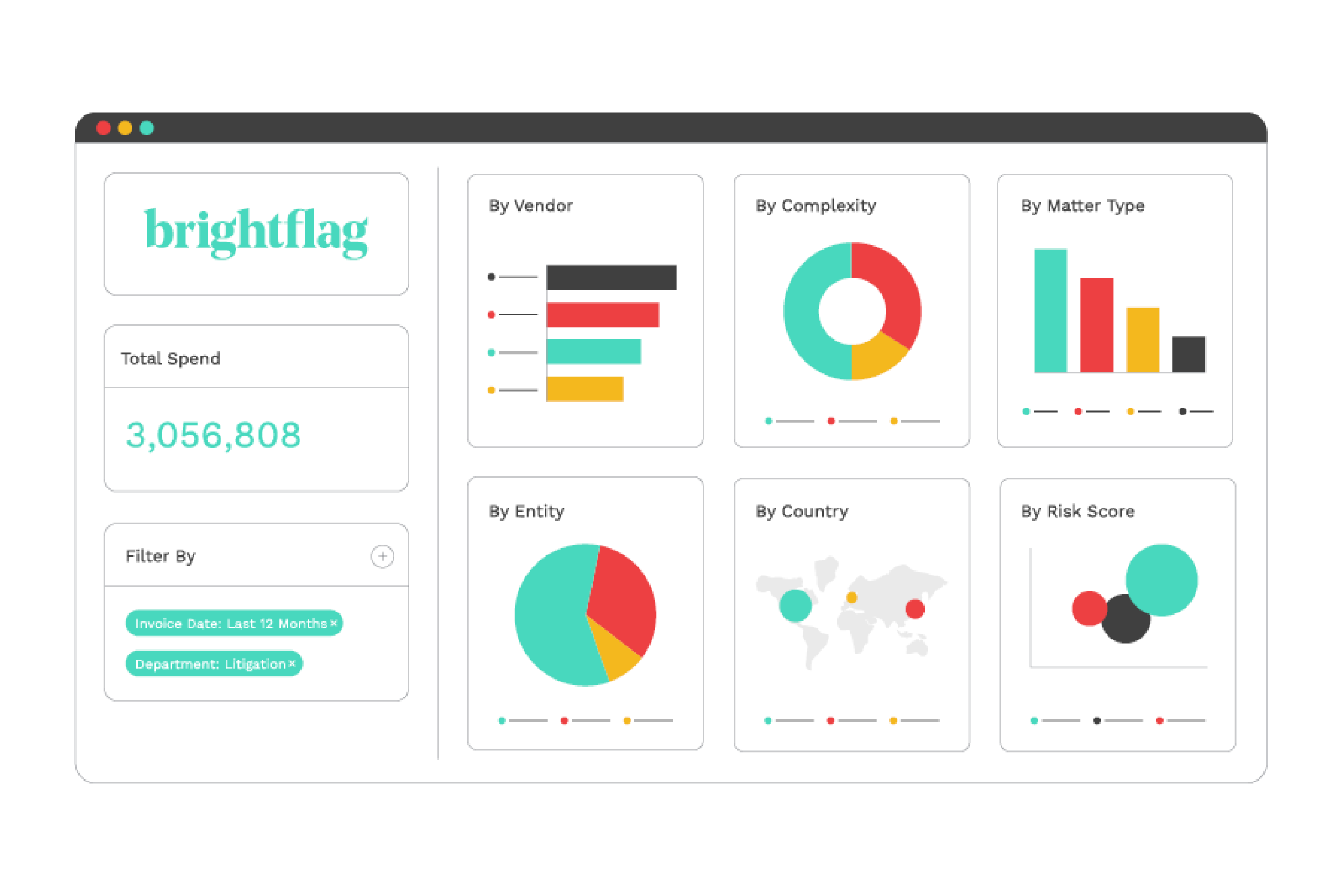Streamlining Our Legal Operations with Brightflag: A Game-Changer in E-Billing Solutions
After a meticulous evaluation of various software solutions, we decided to implement Brightflag as our e-billing platform. This decision was not made lightly; it was the culmination of extensive research, product demos, and feedback from independent reviewers.

As our legal department ventured into the digital transformation journey, we recognized the pressing need to modernize our invoice management system. The traditional methods of handling legal invoices through emails and PDFs were no longer sustainable for our global operations. After a meticulous evaluation of various software solutions, we decided to implement Brightflag as our e-billing platform. This decision was not made lightly; it was the culmination of extensive research, product demos, and feedback from independent reviewers who highly recommended Brightflag for its innovative approach to legal spend management.
Brightflag stood out for several reasons. The product demonstrations were not only convincing but showcased a depth of understanding of the challenges legal departments face in managing invoices and legal spend. Moreover, the sales team at Brightflag distinguished themselves with their knowledge, professionalism, and a notably non-pushy approach, making the decision process much more comfortable for us.

Building Internal Consensus for Adopting Brightflag
The adoption of a new technology tool, especially one that intersects multiple departments like legal, IT, and finance, requires not just a strategic decision but also a concerted effort to build consensus among all stakeholders involved. Our journey towards adopting Brightflag as our e-billing solution underscored the importance of this collaborative approach. Before any agreements were signed or implementations commenced, it was crucial to ensure that our IT and Finance teams were not only informed but fully on board with this transformative decision.
Engaging Stakeholders Early
Recognizing the impact that Brightflag would have on our organization's workflows, data management, and financial tracking, we initiated a series of discussions with key stakeholders from our IT and Finance departments. The aim was to create a transparent and inclusive environment where the purpose, benefits, and implications of adopting Brightflag could be openly discussed.
These meetings were not merely informative but interactive; we solicited input, concerns, and suggestions from all stakeholders involved. This inclusive approach served a dual purpose: it allowed us to leverage the expertise of our IT and Finance teams in evaluating the technical and financial aspects of the Brightflag solution, and it ensured that these key departments felt a sense of ownership and commitment to the project's success.
The Implementation Journey
Embarking on the implementation of Brightflag, we were met with a meticulously structured plan led by an exceptionally competent and knowledgeable product expert. This phase was critical, given our complex needs: we had to integrate hundreds of legal entities into the system and connect with around fifty legal providers. Despite these complexities, Brightflag's platform handled everything seamlessly. The implementation process was smooth and efficient, thanks to the expert guidance and clear communication from the Brightflag team.
Brightflag: A Matter-Driven Platform
Brightflag's platform is fundamentally driven by 'matters', analogous to files or cases in law firms. This structure is pivotal as it allows us to associate each invoice with a specific matter, enabling us to drill down into our legal spend with unprecedented granularity. This matter-centric approach provided us with insights into various aspects of our legal operations that were previously obscured by the cumbersome and disjointed invoice management process.
By associating invoices to matters, we could dissect our legal spend across multiple dimensions: identifying which entities were incurring costs, which legal providers we were engaging with most frequently, the types of matters consuming the majority of our budget, and the jurisdictions where our legal expenditures were highest. This level of detail was transformative, offering a clear, data-driven picture of our legal operations and spend.
After using the Brightflag extensively, I can say that good organization of matters within the platform is extremely important. First, it's important to create different matters for firms or vendors to bill against and it helps to communicate and align with the external provider what matter you want them to bill against. Second, it's important to close matters when you no longer want firms to be able to be able to bill against the matter. For example, if you have an M&A matter and the transaction closes, you'll want to close the matter after all bills have been received relating to the transaction so that the firm doesn't continue billing unrelated work against the matter.
One area where I think Brightflag could improve is the function that allows firms to request new matters. Unfortunately, when such a request is created by the firm Brightflag doesn't effectively communicate the request to the in-house department's users and consequently requests can go unresponded to for days until someone checks the matter requests page. It's not a big deal, but definitely a function Brightflag could improve upon. While we are on the topic, I don't particularly like firm requested matters. We manage hundreds of matters and maintaining an orderly naming convention is extremely helpful for us. Often when a firm submits a matter requests, I need to correct most of the information that's been provided by the firm.
The Impact of Brightflag
Once Brightflag was fully implemented and properly set up, the platform revolutionized our understanding of and interaction with legal data. The once daunting task of managing and analyzing legal invoices became a streamlined, intuitive process. Brightflag's user-friendly interface and robust analytical tools made it easy to extract meaningful insights from our legal spend data.
The platform's impact extended beyond just operational efficiency. It enabled strategic decision-making, allowing us to identify opportunities for cost savings, optimize our legal provider relationships, and ensure compliance across all jurisdictions. Brightflag has not just been a tool but a strategic partner in our quest for operational excellence in legal spend management.
Brightflag will flag opportunities for savings and easily allows you to push back on certain practices like block billing or billing for administrative time. But, while the functionality is there, our in-house department has been reluctant to use the functionality and are more likely to negotiate an overall percentage discount with a firms rather than opposing certain line items in invoices. That said, it's helpful to see which firms are billing contrary to our billing guidelines and Brightflag best practices.
Streamlining the Approval Process: Integrating Brightflag with Our ERP System
A pivotal moment in our journey to optimize legal operations came when we decided to integrate Brightflag with our Enterprise Resource Planning (ERP) system. Initially, our approval process within Brightflag was set up to generate email notifications for each approved invoice. This system, introduced a redundancy that we quickly identified as an area for improvement. Each invoice approved in Brightflag then required a secondary approval within our ERP system, duplicating efforts and complicating our workflow.
Recognizing the inefficiency of this two-step approval process, we embarked on a mission to create a more streamlined workflow by integrating Brightflag directly with our ERP system. This strategic move was aimed at eliminating the need for duplicate approvals, thereby enhancing our efficiency and reducing the administrative burden on our team.
The Integration Process
The integration process involved a thorough analysis of our existing workflows and the technical specifications of both Brightflag and our ERP system. Our objective was to create a seamless flow of data that would allow invoice approvals in Brightflag to automatically update our ERP system, thus consolidating the approval process into a single step.
To achieve this, we worked closely with the technical teams from Brightflag and our ERP provider, outlining our requirements and the desired workflow. The collaboration was instrumental in developing a customized integration solution that met our specific needs. Through API (Application Programming Interface) technology, we were able to establish a direct link between Brightflag and our ERP system, enabling real-time data synchronization.
The Outcome
The integration of Brightflag with our ERP system has transformed our invoice approval process. Once an invoice is approved in Brightflag, the information is automatically relayed to our ERP system, negating the need for a second approval. This streamlined process has not only reduced the time and effort involved in managing invoices but also minimized the potential for human error associated with manual data entry and duplicated approval steps.
Moreover, this integration has provided our finance and legal teams with a unified view of legal spend, directly within our ERP system. This consolidated view supports better budget management, financial forecasting, and overall spend analysis, contributing to more informed strategic decision-making.
Reflecting on Our Agreement Negotiation with Brightflag
The negotiation of our agreement with Brightflag was a key phase in our partnership and a testament to their reputation as a forward-thinking provider. Throughout the negotiation process, Brightflag presented terms that were fair and reflective of what one would anticipate from a leading technology provider in the legal space. Their approach was transparent, cooperative, and demonstrated a strong willingness to align their services with our needs, reinforcing our decision to choose them as our e-billing solution provider.
Brightflag's commitment to customer success was evident through their flexibility and the robust support structure they offered. The terms of the agreement were structured to provide us with a comprehensive understanding of the services, support, and scalability offered by the platform. We felt confident in the value that Brightflag would bring to our legal operations and the positive impact it would have on our invoice management and legal spend analytics.
A Lesson in Forecasting Legal Spend
However, in hindsight, one aspect of the negotiation that we could have approached differently was our projection of how our legal spend would evolve over time. In the initial stages of our partnership, we established spend thresholds based on our current understanding and forecasts of legal expenditure. These thresholds were integral to the pricing structure and the overall cost of using the Brightflag platform.
As our operations grew and our use of legal services expanded, we quickly realized that our initial legal spend forecasts were conservative. We outpaced the first spend threshold much sooner than anticipated, leading to a situation where, by the second year, we were paying more for Brightflag's services than we initially expected. This was not a reflection on Brightflag’s pricing or value proposition but rather an underestimation on our part of our own growth and the resulting increase in legal spend.
This experience underscored the importance of forward-looking financial planning, especially when negotiating agreements for services that are closely tied to business scale and operational scope. It taught us valuable lessons about anticipating future needs and incorporating flexibility into contracts to accommodate growth and changes in service usage.
From Estimation to Precision: Transforming Legal Spend Visibility
The journey of our General Counsel (GC) from grappling with ambiguous legal spend figures to wielding precise, detailed financial data exemplifies the transformative power of adopting the right technology. Before the integration of Brightflag into our legal operations, our GC, like many others in similar positions, faced the challenge of managing and reporting on legal spend with a degree of uncertainty. The reliance on fragmented data sources, manual invoice processing, and the inherent delays in collating financial information contributed to a hazy picture of our legal expenditures. This opacity was not just an internal issue; it posed significant challenges when explaining and justifying legal costs to upper management, a critical aspect of strategic decision-making within any organization.
Embracing Precision with Brightflag
The adoption of Brightflag marked a pivotal shift in how we approach legal spend management. Through its sophisticated analytics and comprehensive reporting capabilities, Brightflag provided our GC with an exact calculus for tracking every dollar spent on legal services. This level of detail and precision was unprecedented and proved to be a game-changer for our legal department.
Conclusion: Reflecting on the Strategic Decision to Begin Our Tech Adoption Journey with E-Billing
Embarking on a technology adoption journey in a legal department is a decision fraught with considerations, potential impacts, and long-term implications. Our choice to initiate this journey with the implementation of an e-billing system was not just a strategic move but a foundational step towards transforming our legal operations. This decision, upon reflection, has proven to be not only prudent but transformative, setting a course that has fundamentally enhanced our approach to legal spend management and operational efficiency.
The adoption of an e-billing solution, specifically Brightflag, as our entry point into legal tech modernization has yielded profound insights and benefits. One of the most significant advantages has been the ability to gain a clear, detailed understanding of our legal spend. This clarity has been instrumental in navigating the subsequent stages of our tech adoption journey, particularly in evaluating and deciding on other software solutions.
A Foundation for Informed Decisions
Having a precise grasp of where and how our money is being spent has empowered us to make informed decisions about our legal department’s needs and priorities. The visibility and control over our legal spend facilitated by our e-billing platform have provided a solid foundation for assessing the value and potential ROI of additional legal tech investments. This approach has allowed us to strategically allocate our resources, ensuring that each subsequent technology adoption brings us closer to our goal of operational excellence.
Enabling Strategic Budgeting and Investment
Moreover, the insights gained from our e-billing system have been invaluable in shaping our budgeting strategy. Understanding our spending patterns, identifying areas of inefficiency, and recognizing opportunities for cost savings have enabled us to reallocate funds more effectively. This strategic budgeting approach has opened up new avenues for investing in technologies that further our department's efficiency, effectiveness, and alignment with the broader organizational goals.




Comments ()